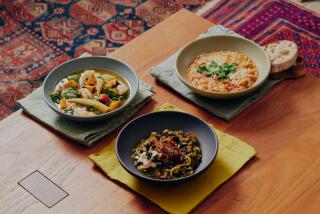A Fine Kettle of Fish?
I suppose it hit me when my wife walked in the front door after running an errand. “What is that smell?” she asked, rushing into the kitchen to open windows. “We don’t have cats.”
No, we don’t have cats. But we did have anchovies--quite a lot, actually--stewing in a small saucepan. I was stirring them as they crumbled into an ugly paste the color of bad olives with the pungent aroma of, yes, wet feline.
I was making anchoiade, a Provencal anchovy sauce I planned to serve with celery and fennel sticks that night as an appetizer.
And that’s when it occurred to me: Here I was in Southern California trying to make anchoiade, a rustic dish from the south of France, when I have never been to the south of France and have never, to the best of my memory, eaten what could be considered an authentic anchoiade.
Welcome to American cooking in the 1990s. Perhaps never before in the course of human cooking have so many attempted to do so much with so little (actual knowledge, that is).
In other places and other times, you cooked what your parents had cooked and what their parents before them had cooked. Except for a few cataclysmic events--the discovery of the New World and all of its bounty, for example--the roster of dishes and ingredients stayed pretty much the same for generations.
In most places in the world, that’s still the way cooking is done. After all, how many Provencal cooks do you think were spending that very same afternoon stirring, say, a big pot of menudo and wondering if it was really supposed to smell that way? (And maybe wishing they’d stuck with something they knew--like anchoiade.)
But we are cooks unbound, unrestrained by borders and even continents. My next-door neighbor, for all I know, may have spent that afternoon experimenting with Cambodian noodles while the guy across the street was fixing a rice dish from Iran.
This, of course, is only natural in Southern California, where your neighbors are likely to be Cambodian and Iranian. But I’m not, and neither am I southern French. And I don’t have to be. All I have to do is go to my study and thumb through a couple of cookbooks.
When I lived in Texas, there was a popular bumper sticker that read: “I’m not a cowboy, I just bought the hat,” referring to another kind of lifestyle tourism. The culinary equivalent might be: “I’m not Tuscan, I just bought the book.”
Given the right book, maybe that’s enough. Granted, we can never create a culturally authentic version of one of those recipes without moving to the region in question, cooking with the exact same ingredients and serving them in the exact same way. But we can come pretty darned close to a reasonable reproduction if the author is good enough and the directions clear enough.
But how do we know that? How is the cook--toiling alone, stirring that stinky, sticky kettle of fish--to know whether his guide is Stanley or Livingstone? Will he find some delicious masterpiece or end up lost in a dinner-time jungle with something resembling cat food?
There are clues that cookbook readers learn to recognize: a sense of place, the knowing tip, the author’s ability to make you see and smell what is happening in the cooking process.
But finally, it’s all a matter of faith. While my wife scurried about trying to air out the house, I cut the anchovies with olive oil, then added a couple of minced garlic cloves. The disparate pungencies mingled and smoothed into something deep and tangy.
I cut a chunk of fennel and tentatively dipped it into the sauce. The paste tasted almost exactly the way I wanted it to: savory, brassy and honest--just the right thing to serve with drinks before dinner. OK, so maybe it wasn’t the archetypal anchoiade, but how would I really know if it was?
ANCHOIADE
This is Susan Herman Loomis’ version of anchoiade from her new book “French Farmhouse Cookbook” (Workman, $15.95). She confesses: “Anchoiade is not a vision of loveliness--the anchovies tend to sink while the oil tends to rise. My suggestion for serving? Use a smallish dark-hued bowl, and the looks won’t matter a bit.” Serve the anchoiade with celery and fennel sticks and radishes. It is traditional to serve it with toasted bread slices as well.
40 anchovy fillets, or 20 whole anchovies, preferably in salt, washed and, if whole, bones removed
1/2 cup milk
1/2 cup extra-virgin olive oil
2 cloves garlic, minced
1 teaspoon red wine vinegar
Cover anchovy fillets with milk in small bowl and let soak 15 to 20 minutes. Drain, rinse quickly under running water and gently pat dry.
Heat anchovies over medium heat in small saucepan, stirring constantly to break up fillets. Slowly add oil, continuing to stir, until anchovies form paste.
Add garlic, then vinegar and cook, stirring, just until mixture is blended, 2 to 3 minutes. Anchovies won’t be entirely smooth and sauce won’t be emulsified; it will have somewhat rough-looking texture. Keep warm over very low heat until ready to serve.
Makes 1/2 cup. Each teaspoon:
57 calories; 247 mg sodium; 6 mg cholesterol; 5 grams fat; 0 carbohydrates; 2 grams protein; 0 fiber.
More to Read
Eat your way across L.A.
Get our weekly Tasting Notes newsletter for reviews, news and more.
You may occasionally receive promotional content from the Los Angeles Times.











